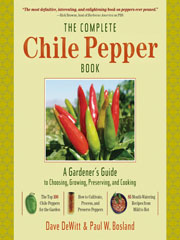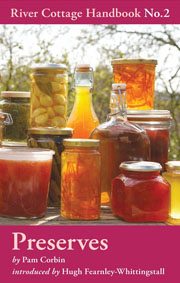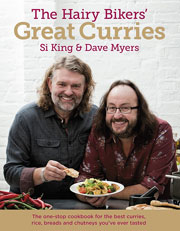As the popularity of growing chillies increases so does the bewildering number of varieties out there. One great way to experiment with growing different varieties is to save seeds from your current plants and swap seeds with fellow chilli growers. You can even experiment by trying to cross pollinate your plants and create new varieties.
In this article we’ll discuss how to save chilli seeds as well as touching on the concepts of cross pollination and hybrid plants and what these mean if you plan to save some seed for next years plants.
Cross Pollination
Ideally if you’re saving seed from your pepper plants all your different varieties would have been grown in isolation. If the plants were not isolated during the flowering stage, there is a fair chance that any the insect (or even gust of wind) that pollinated your pepper plant came from a different variety plant just before. This could mean that the seed you’re saving will be ‘hybridized’ or a genetic mix of two different plants and/or varieties.
Hybridizing chilli plants is an unpredictable business. While cross pollinating plants within the same species usually results in strong healthy plants with reliable fruit, cross pollinating between different species can be far more unreliable.
Cross species hybrids can produce anything from the next big blistering hot variety to heatless, misshapen, low yielding varieties so be prepared for failures and always be sure to not rely on your hybrids next year by having some ‘true’ seed to plant too.
Avoiding Cross Pollination
While we’ve talked a lot on the site about encouraging insects to our chilli plants to help pollination, chilli plants are in fact capable of self pollination. While instances of flower drop may increase without insects pollinating between flowers the fact that chili plants contain both the male and female reproductive organs is great news if you’re trying to isolate plants in order to preserve their ‘true’ seed for future years.
If you can’t physically separate your chilli plants (not many of us have multiple greenhouses!) one way to avoid your plants cross pollinating is to cover them in very fine netting to prevent insects from cross pollinating. You can either cover the whole plant in netting or simple cover individual flowers before they open up.
Another very effective method I’ve used is to buy empty gelatine capsules (readily available on Amazon) and place them over new flowers before they open (see the picture below). They prevent any cross pollination from occurring until the pod is set inside the flower.
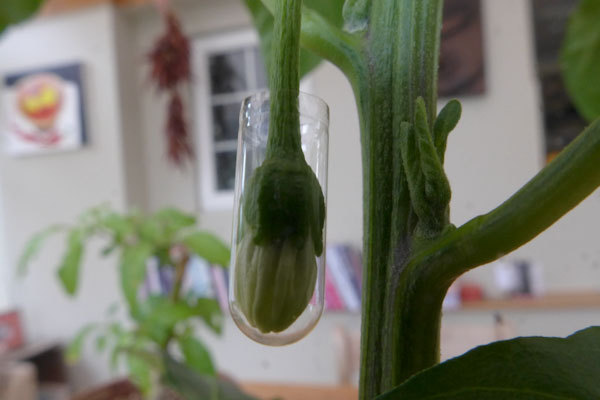
Once the flower is self pollinated and the pod begins to form inside it will begin to burst through the gelatine pod leaving you with a pure or true pod full of viable seeds. Once the pod starts to force it’s way out of the capsule I usually give them a good spray of water to help soften the capsule.
It is worth noting that the Capsicum Pubescens strain (otherwise known as Rocoto varieties) are unable to cross pollinate with the other species of chillies. This makes them ideal candidates to save seed from as there no risk of the child plants being hybrids even if they are grown amongst other species.
Plant & Pod Selection
The key to selecting the right seeds is to choose the healthiest looking pods from the healthiest looking plants in your crop. If at all possible choose plants that have been isolated (see the section on cross pollination above) and avoid any F1 species.
There have been various studies done that indicate the best germination rates come from pods picked at their ripest. While seed can be harvested from under/over ripe pods always try to save seeds from perfectly ripe pods to increase the viability of your seed.
Below I’ve selected and Aji Hot (Capsicum Baccatum species) that has been growing in isolation in our conservatory over the summer.
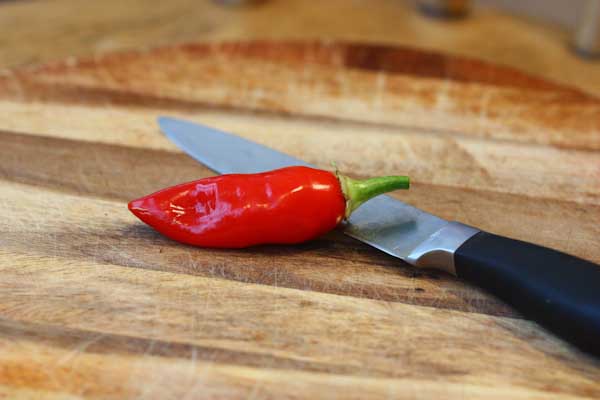
F1 plants (often sold by commercial growers) are the first generation hybrids which while often making prolific plants are not good for saving seed from. The 2nd generation plants are very unreliable and will often produce deformed pods or pods with no heat. As a result always try to ensure that the plants you save seed from are true plants and not hybrids themselves.
Harvesting Chilli Seed
Once you’ve selected the pods to take your seed from snip off your chosen pod/s with scissors or a sharp knife to avoid damaging the plant. Cut open the pod and with a knife carefully separate out the seeds from the pod and pith that holds the seeds in place. Be careful not to damage any seeds.
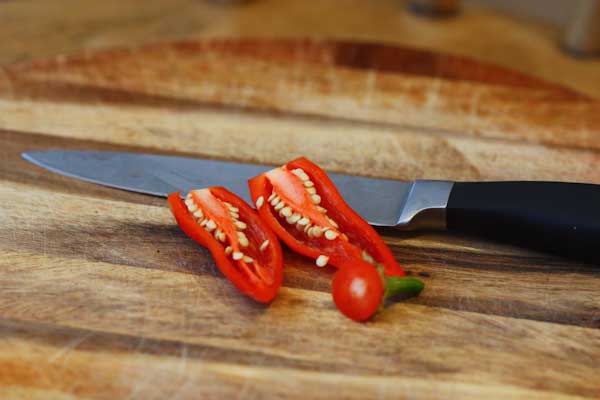
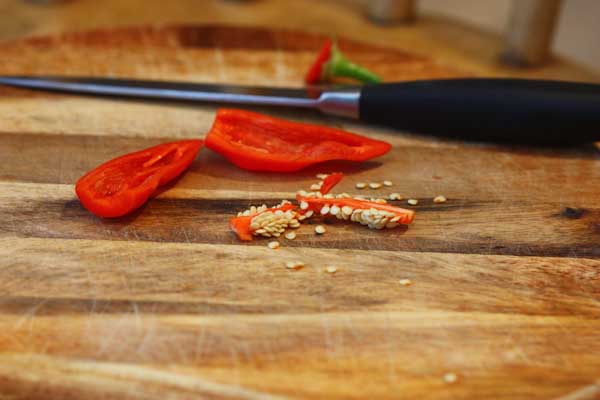
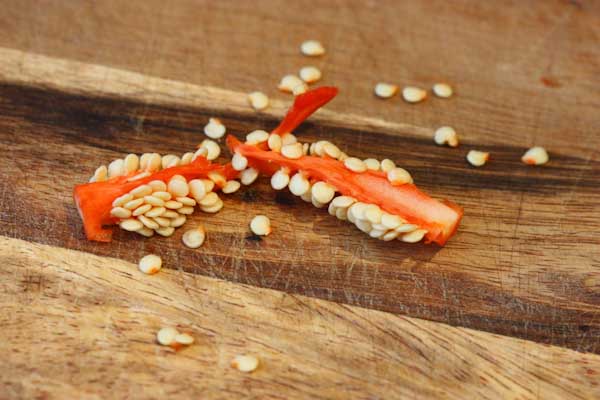

Place the seeds on a piece of kitchen paper and carefully inspect them. Remove and discard any seeds that appear misshapen, discolored, under developed or abnormal in any way. The aim here is to only keep the strongest healthiest looking seeds as these will have the best germination rates.
Drying
Using a second piece of kitchen towel carefully pat the seeds dry to remove any excess moisture. Next place the seeds somewhere warm such as an airing cupboard for about 2 weeks so they dry out thoroughly. I usually turn the seeds every other day to ensure they dry evenly and any dampening off is avoided.
Storage
Seeds that are stored in good conditions will keep for several years. Over time germination rates decline however if you’re reasonably careful with storage your saved seeds should keep for a couple of years without your germination rates declining too dramatically. The idea is to store the seeds in conditions like they experience in the wild over the winter, while the wait for warm spring soil to germinate in. A cool, dark environment slows the metabolism down making them last longer.
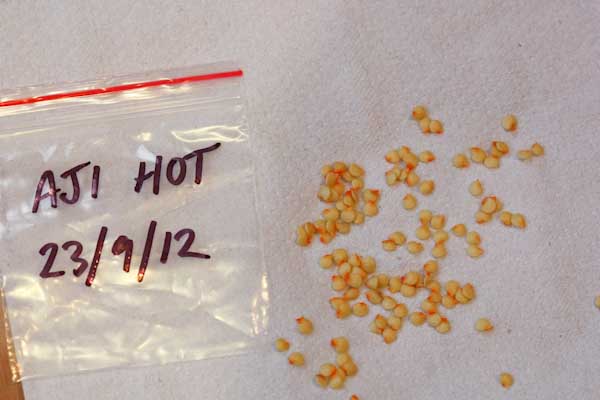
Drying times will vary depending on where you’re drying them. Your aim is for the seed to be brittle and not ‘bendy’ when squeezed. I find 2 weeks in a warm airing cupboard is about right. Another great method is to dry them in an open oven set very low for about 4 hours.
Once your seeds are dry it is important to keep them both dry and cool (below 40 degrees Farenheit which is around 4 degrees celcius). For the temperature I use either the fridge or freezer.
In order to keep the seeds moisture free they need to be in an airtight container. By airtight we mean something that would keep them dry if placed under water. We start off by placing the seeds in small sealable plastic bags which in turn get placed within air tight plastic containers. Always be sure to clearly label the seed (including the date harvested)
Seeds that has been correctly harvested and stored should remain viable for between 1 and 5 years fairly easily and often for much much longer. However the longer the seed is stored and the less you follow these guidelines the lower your germination rates will be. As a rule I tend not to try and use seeds within 2-3 years and always save some from each variety I grow every year. If I have left overs I prefer to swap with other growers and exchange for varieties that I haven’t grown before.

